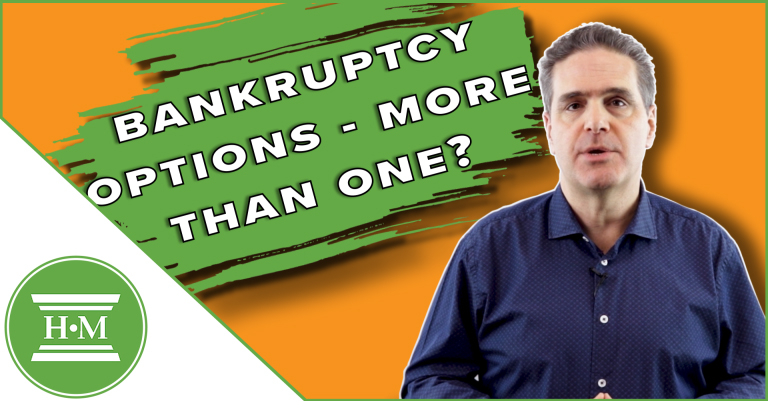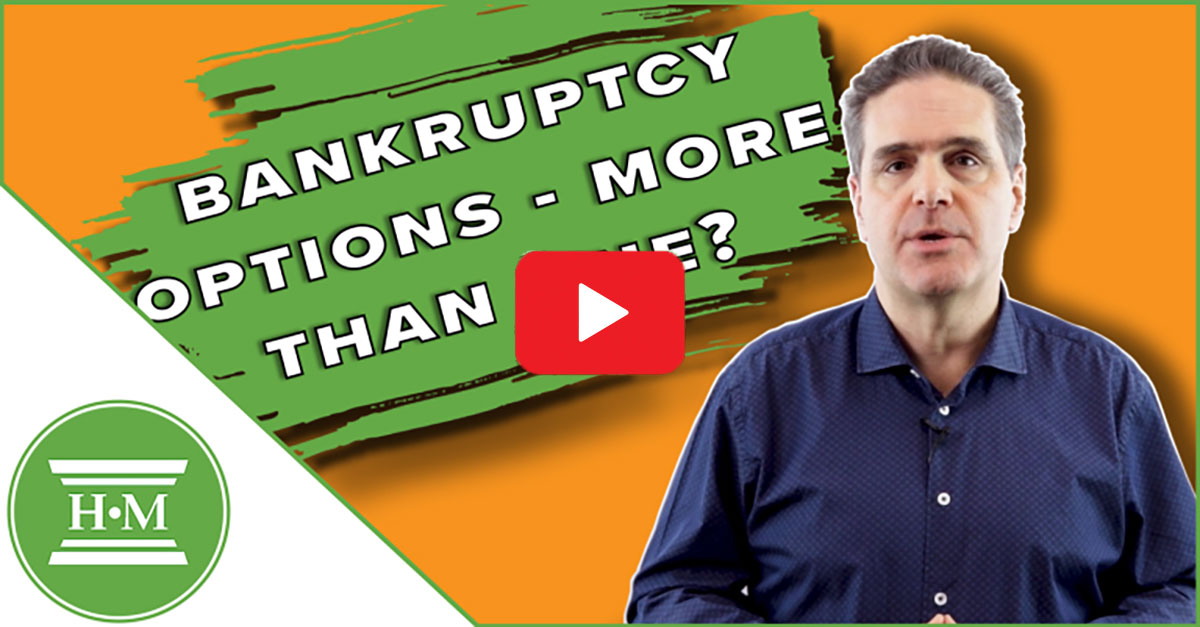
When debts become overwhelming, filing for bankruptcy might be your best path forward. However, there isn’t just one type of bankruptcy in Canada – there are four distinct bankruptcy options, each offering different advantages depending on your circumstances. Under Canada’s bankruptcy laws, these options offer different paths to bankruptcy protection while helping you become debt free.
Table of Contents
The Main Types of Bankruptcy in Canada

The Bankruptcy and Insolvency Act (BIA) defines the legal options for relieving an individual or company of its obligation to repay debt.
In Canada, there are four different types of bankruptcy proceedings, each with its own set of rules and procedures:
- Personal Bankruptcy: For individuals and sole proprietors with unsecured debts they cannot repay.
- Consumer Proposals: For individuals with up to $250,000 in debt who can repay a portion of what they owe.
- Division I Proposals: For both businesses and individuals with debts over $250,000
- Business Bankruptcy: For incorporated businesses facing insolvency
All bankruptcy options under the BIA must be filed with a Licensed Insolvency Trustee (LIT).
You may have heard of a Chapter 7 bankruptcy and Chapter 13 bankruptcy. These are bankruptcy options available only in the United States. Chapter 7 is like filing personal bankruptcy in Canada, and Chapter 13 is like a consumer proposal.
Personal Bankruptcy
Personal bankruptcy is a legal process that helps individuals and sole proprietorships eliminate their unsecured debt. Upon filing for bankruptcy, you must relinquish all non-exempt assets and make monthly payments to a trustee. In return, your debts are discharged, offering a fresh financial start.
Who administers: Licensed Insolvency Trustees administer two forms of personal bankruptcy: summary administration and ordinary administration bankruptcy. For individuals, a summary administration is the most common and applies when the value of your assets does not exceed $15,000. Trustee fees are fixed by bankruptcy legislation based on the amount of realizations distributed to the creditors.
Eligibility: To qualify, you must owe at least $1,000 and be unable to meet your debt obligations as they come due. If you carry several thousand in consumer debt like credit cards or payday loans and have no hope of repaying that amount in full, then bankruptcy is worth exploring. A Licensed Insolvency Trustee will review your situation to confirm you are insolvent.
Process: The bankruptcy process typically lasts 9 months for a first-time bankruptcy if you have no surplus income. If your income exceeds the federal government’s threshold, your bankruptcy will be extended to 21 months. During this time, you’ll make monthly payments based on your income and attend two financial counselling sessions. Upon completion, you will receive a bankruptcy discharge, releasing you from further obligation to repay your debts.
Effects: When you file personal bankruptcy, you surrender certain assets to your trustee, though many personal belongings are exempt under provincial laws. Your unsecured debts are eliminated upon discharge, except for certain obligations like recent student loans and support payments. Upon filing for bankruptcy, a note will appear on your credit report and remain there for six years after your discharge. This can negatively impact your credit score; however, the benefit of a fresh start often outweighs the temporary impact.
Consumer Proposals
A consumer proposal is technically not a bankruptcy but a legal insolvency option to help individuals restructure their debt. It has become increasingly popular in recent years, now accounting for more than 80% of consumer insolvencies across Canada. A consumer proposal allows you to make an offer to pay your creditors a percentage of what you owe through a structured payment plan over a maximum of 5 years. Settlement offers can be as low as 20% of your debt, depending on your income and assets.
Debts covered: A consumer proposal eliminates the same types of debt discharged in a bankruptcy. This can include credit card debt, lines of credit, student loans (if you have been out of school for 7 years), payday loans, personal loans, government debts including money owed to the Canada Revenue Agency, overdue bill payments, bank overdrafts, and any unsecured debt owed to an individual, financial institution, or business.
Eligibility: To be eligible, your total unsecured debts must be less than $250,000, excluding your principal mortgage.
Process: A consumer proposal must be filed with a Licensed Insolvency Trustee. Your Licensed Insolvency Trustee will help determine a monthly payment amount that you can afford and that your creditors are likely to accept. Once signed, your proposal is sent to your creditors for a vote. If accepted by the majority based on dollar value, you make monthly payments until the proposal is complete. Upon completion, the remainder of your debt is forgiven.
Effects: Unlike bankruptcy, you keep your assets in a consumer proposal. A consumer proposal has less of an impact on your credit score than a bankruptcy filing. A consumer proposal will stay on your credit report for three years after completion (and sometimes less) compared to six years for bankruptcy.
The main advantages of a consumer proposal vs bankruptcy are that you keep all your assets, payments can be spread out over a period of up to five years, and monthly payments are much more affordable.
If your debts exceed this amount, you can still make a proposal to creditors through a process known as a Division I proposal.
See what your consumer proposal might cost with our consumer proposal calculator:
Enter Your Total Unsecured Debt
| Options To Eliminate Your Debt |
Monthly Payment (approximate) Over 5 Years |
Total Cost Over 5 Years |
Total Savings Over 5 Years |
|---|---|---|---|
|
Consumer Proposal Pay Less than Principal Debt Amount |
|
||
|
Credit Counselling No Principal Reduction |
|
||
|
Debt Consolidation Added Interest Costs |
|
||
|
Repay Debt on Your Own Added Interest Costs |
|
Need help with your debt?
Book a Free Consultation
Division I Proposals
A Division I Proposal is a formal debt settlement option for businesses or individuals with debts exceeding $250,000.
There are also some administrative differences between a consumer proposal and a Division I proposal. For an individual, the biggest consequence of filing a Division I proposal is that you are automatically deemed to be bankrupt if the proposal is rejected. This is not the case with a rejected consumer proposal where the individual can choose to file bankruptcy, make another consumer proposal or continue to deal with creditors on their own.
The voting threshold is also higher – you need a majority of creditors holding two-thirds of the debt value to approve the proposal.
Like consumer proposals, you can keep your assets while repaying a portion of your debt. However, Division I proposals also require more detailed financial reporting and may involve the bankruptcy court.
Business Bankruptcy
Business bankruptcy applies specifically to incorporated businesses. In Canada, a sole proprietor, self-employed contractor, or partner in an unlimited partnership files personal bankruptcy to deal with both business debts and personal debts. This is the most common form of small business bankruptcy. When a corporation files for bankruptcy, the process is separate from its owners’ personal finances, protecting their personal assets unless they’ve signed personal guarantees for business debts.
While a Licensed Insolvency Trustee is appointed to administer a corporate bankruptcy, most business bankruptcies also require the involvement of a bankruptcy lawyer to deal with any court issues that arise. The process involves the liquidation of company assets and the distribution of proceeds to creditors.
The duration and complexity of business bankruptcy depend on the size of the business and complexity of its affairs. Unlike personal bankruptcy, there is no automatic discharge for corporate bankruptcies.
Choosing the Best Bankruptcy Option
Each bankruptcy option above is a legal procedure under the Bankruptcy and Insolvency Act. Licensed Insolvency Trustees are Canada’s only professional debt advisors who can administer these proceedings. The first step in considering whether any bankruptcy option is right for you is to talk with a Licensed Insolvency Trustee.
We know that bankruptcy is a last resort. In addition to solutions like personal bankruptcy, your trustee will help you consider alternatives to bankruptcy, including a consumer proposal, credit counselling, a debt management plan or debt consolidation.
If you need debt help, contact Hoyes Michalos for a free consultation with a Licensed Insolvency Trustee. They will discuss your options in detail and with no judgment to help you decide on what alternative will help you become debt-free and build a better financial future.
Get A Personalized Debt Free Plan
"*" indicates required fields
Related Questions
What is the most popular type of bankruptcy? For individuals, consumer proposals have become the most popular insolvency option in Canada, with more than 80% of Canadians choosing this option over traditional bankruptcy.
If I own a small business, which type of bankruptcy should I file? If you’re a sole proprietor, you’ll file personal bankruptcy, which will discharge both business and personal debts. Incorporated businesses file corporate bankruptcy, which keeps the liquidation of business assets separate from personal assets.
Can a creditor force me into bankruptcy? Yes, creditors can petition you into bankruptcy through a court process called involuntary bankruptcy. However, this is rare because it’s expensive and time-consuming for creditors. Most bankruptcies in Canada are voluntary, meaning the person chooses to file bankruptcy with a Licensed Insolvency Trustee to deal with their debts.
Can I file for bankruptcy online? In Canada, LITs are permitted to perform a debt assessment via video-conferencing, and you can sign your documents digitally. However, only an LIT is able to file your bankruptcy with the Office of the Superintendent of Bankruptcy and the Court.
Can I be denied personal bankruptcy in Canada? No, you cannot be denied bankruptcy if you meet the minimum qualifications: owing $1,000 in unsecured debt, the inability to pay debts as they come due, and residing or having property in Canada.
Will I have to attend bankruptcy court? Most people who file for bankruptcy never need to go to court. Your Licensed Insolvency Trustee handles all the paperwork and administrative aspects of your bankruptcy. You only need to attend court if your discharge is opposed by your trustee, creditors, or the Office of the Superintendent of Bankruptcy, which happens in less than 1% of cases.
What are the steps involved in filing for bankruptcy? The process begins with consulting a Licensed Insolvency Trustee who will assess your situation, explain your options, and help you complete the necessary paperwork. They’ll guide you through the entire process from filing to discharge.
What assets cannot be seized in a bankruptcy? Both federal law and provincial legislation define bankruptcy exemptions. In general, you can keep most clothing and household belongings, a motor vehicle, and tools of the trade up to a certain limit, RRSP contributions not made in the past year, and most pension plans and life insurance policies. House and real estate limits vary by province, so talk with your local Licensed Insolvency Trustee.
Who can help with filing for bankruptcy in Canada? Only Licensed Insolvency Trustees can administer bankruptcies and consumer proposals in Canada. They are federally regulated professionals who provide advice about your debt relief options and handle all aspects of the filing process.
How much do you pay for bankruptcy? The minimum cost to file personal bankruptcy in Canada is around $1,800. This covers the administration costs of your file. If, however, you have significant assets or surplus income, the law increases these minimum payments. If you have a high income, a consumer proposal is often the best option to keep your monthly payments low.





